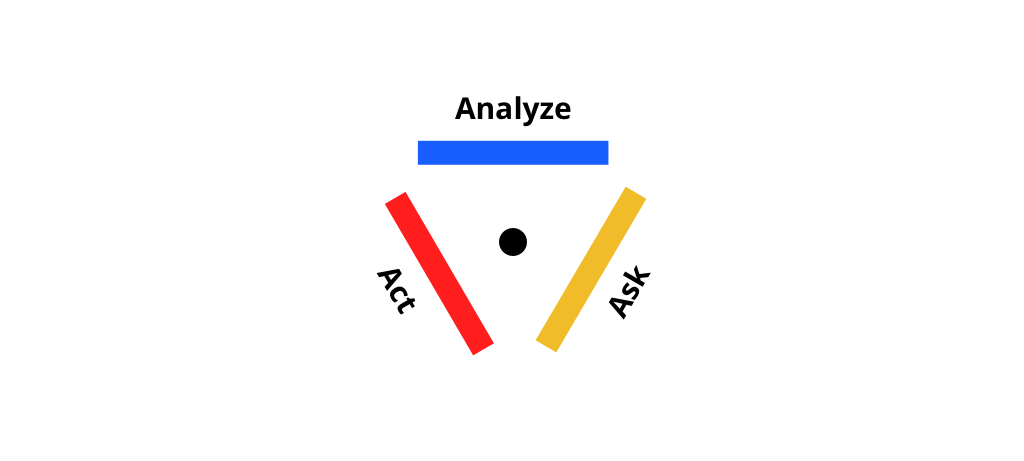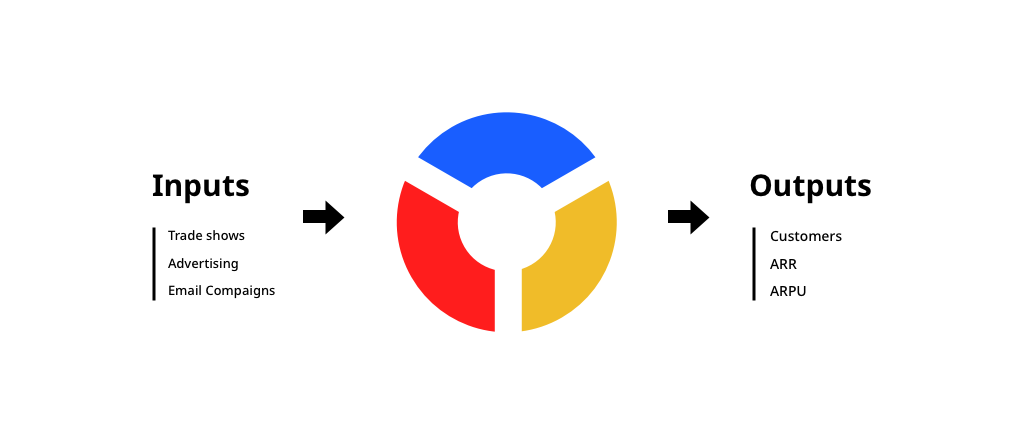At the Product-Led Institute, we developed the “Triple-A” sprint, which focuses on rapidly identifying problems, building solutions, and measuring impact. The process follows a one-month sprint cycle and consists of three “A’s”:
- Analyze;
- Ask;
- Act.

The Triple-A sprint gives you a way to build a sustainable growth process and can be used by any team in your business.
Still, if you have a bad product, no optimization will deliver rocketship growth. Just because you put sprinkles on a turd does not transform it into a brownie. At the end of the day, it’s still shit. On the other hand, if you have a good product that customers love, you’ll see a monumental shift if you go through a Triple-A sprint each month.
I’ve seen companies apply this same framework and go from $500,000 ARR to $1 million ARR in less than 12 months. It works.
Tweet this quote
Best of all, it’s not hard to implement. Start by analyzing your business.
The first “A”: Analyze
As Romain Lapeyre, CEO of Gorgias, states, “In order to build a growth machine for your business, you need to analyze your inputs and outputs.”
Until you know the inputs (e.g. trade shows, advertising, email marketing) that drive desired outputs (e.g. ARR, customers, MRR), you won’t build a sustainable business.
Tweet this quote
If you’re not sure which inputs drive the outputs you want in your business, you need to start analyzing your business.

Where to start analyzing your business
Create a recurring calendar notification to remind yourself to analyze your previous month’s results on the first workday of each new month. Block off one or two hours so that you’ll have the time to do a thorough job. You’ll get into a rhythm of analysis.
Start measuring your outputs. Outputs are a reliable indicator of whether you’re doing the right thing — they don’t lie. Let’s dive into the right outputs to track.
Which outputs should you track?
One of the beautiful things about a SaaS business is that you can analyze almost anything. This amount of insight is incredible — until it isn’t. With access to countless metrics, it’s easy to obsess over email opens or bounce rates. Although these metrics can be tracked, they don’t tell you much.
Did your high bounce rate lead customers to churn? Or did it hurt signups? Although a high bounce rate can absolutely contribute to those problems, we still don’t know the root cause. By looking at outputs, we can quickly analyze the area of our business that most requires our attention. That way, we know which areas to troubleshoot.
In a product-led business, these are the macro outputs you need to track:
- Number of signups;
- Number of upgrades;
- Average Revenue Per User (ARPU);
- Customer Churn;
- ARR;
- MRR.
These outputs don’t lie, and they’re easy to find. If you compare these outputs over the course of the last 12 months, you’ll quickly identify the area of your business that’s hurting the most.
Once we know the outputs, we can ask questions to identify the inputs that get us closer to our dream business.
The second “A”: Ask
To optimize any business, you need to ask three questions:
1. Where do you want to go?
Some businesses use a North Star Metric to symbolize this focus, while others pick a revenue number. How you break down your business’ goals is not what this article is about.
If you really have no idea what your organization’s goals are, you should read Measure What Matters by John Doerr. It lays the foundation for how to prioritize the metrics that matter in your business and work to hit them across your entire team.
As an example, let’s say we’re a $10 million ARR SaaS business that has a live-chat solution. Our numeric objective is to hit $15 million ARR in the next 12 months. I’m all for setting ambitious goals, but please do not just “wing it” when it comes to figuring out what to do next. To get your business closer to where you want to go, you need to know which levers to pull.
2. Which levers can you pull to get there?
As I’m writing this article, I’m taking a motorbike course. As a newbie, I’m constantly making mistakes. I’ll shift down a gear when going fast, and my bike will screech and hiss in anger. I’ll hold down the clutch while accelerating only to hear my engine roar and feel my bike slow. I’ll use the front brake while slowing around a corner, toppling my bike onto me — an anti-climatic end that risks embarrassment more than injury.
Knowing which levers to pull is important for business or motorbikes. What’s also true is that there are multiple ways to get the same output. To stop a motorbike, you can use the front, back, or engine brake. Or just drive into the nearest lake. Each of these braking systems achieves the desired output.
There are only 3 levers you can pull for growth: 1. Churn; 2. Average revenue per user (ARPU); 3. Number of customers.
Tweet this quote
It’s the same when it comes to your business. According to Jay Abraham’s multiplier perspective, there are three levers you can pull for growth:
- Multiplier 1: Churn;
- Multiplier 2: Average revenue per user (ARPU);
- Multiplier 3: Number of customers.
When I talk to executives at product-led businesses, most focus almost exclusively on increasing the number of customers; however, when it comes to increasing ARPU or decreasing churn, I hear crickets. This is a huge missed opportunity.
“A healthy growing SaaS company with -5% churn has 73% higher revenue than one with 5% churn.”
Tomasz Tunguz
If our goal is to increase our revenue, why is everyone looking at the customer count?
Drew Sanocki, former CMO at Teamwork.com, found that decreasing his churn rate by 30%, increasing ARPU by 30%, and increasing total customers by only 30% increased LTV by over 100%.
Breaking down your business by three levers lets you quickly identify which levers will help you grow fastest. Unless you’re just starting out, reducing churn and increasing ARPU will almost always have the biggest impact. Once you nail your churn and ARPU, you can start multiplying your business with each additional customer.
Here’s the multiplier formula you can use:
Churn > ARPU > # Customers
Want to see how it works? Fill in the graph below to see which lever will have the biggest impact on your business.
For instance, if you reduce your annual churn rate by 100% in Scenario B, you’ll be able to increase your ARR by 10,000 and see a 12.5% uptick in your ARR from moving just focusing on one metric.

Once you’ve identified the top lever, it’s time to brainstorm which inputs will kick your business into high gear.
3. Which inputs should we invest in?
Once we’ve found where to focus our Triple-A sprint, we can figure out which inputs we should add to or subtract from the mix. If we use the right inputs, our business and outputs will grow.
If we make a mistake and use the wrong inputs, our business will become stagnant or decline.
To help you find the right inputs, recall the UCD framework and why companies fail:
- You don’t understand your value.
- You aren’t communicating your value well enough.
- You aren’t delivering on your value fast enough.
That’s it. Just three potential issues.
Ask yourself: Which part of your business is underperforming?
Brainstorm potential inputs to run experiments. This is easier said than done, but don’t overthink it. If you’re struggling with low signups, do customer research to understand the value your buyer perceives. Then, communicate that value to them.
If you’re struggling with low upgrade rates, work on delivering your value. Cut out every piece of onboarding that doesn’t deliver on your value. As Samuel Hullick cautioned, “People don’t use software simply because they have tons of spare time and find clicking buttons enjoyable.”
To improve your buying experience, buy your product once a month. You’ll quickly spot easy improvements.
Tweet this quote
One way to find opportunities to improve the buying experience is to buy your product once a month. You’ll quickly spot easy improvements. Too often, we set up our onboarding and assume it works without a hitch. (It doesn’t.) I’ve done countless user onboarding audits and found embarrassing bugs that were cratering free-to-paid conversion rates. Anyone could’ve spotted these bugs.
Compile a list of items that could improve your product experience. Filter these ideas. How you do it doesn’t matter as much as having a defined process.
Have a consistent prioritization system, so you can compare the value of very different projects, force priority decisions out into the light, and pressure test assumptions.
Scott Williamson, VP of Product at SendGrid
I use an Input Log as a prioritization system. It helps you track and prioritize every idea that could help your business grow. Then, I use the ICE prioritization method, developed by Sean Ellis, to score each input on three elements:
- Impact.: How big of an impact could this input have on an output I want to improve?
- Confidence: How confident am I that this input will improve my output metrics?
- Ease: How easy is it to implement?
Here’s an example of what this could look like:

You can use any framework you want; however, if you don’t have an existing prioritization system, start with the ICE score framework. It’s easy to understand and implement.
Once you’ve run through the ICE method to filter your ideas, find the one or two opportunities to implement that will have the biggest impact on your business. Now, put those ideas to good use.
The third “A”: Act
Ideas are easy. Execution is everything.
It’s not enough to be busy, so are the ants. The question is, what are we busy about?
Henry David Thoreau
Once you’ve chosen the one or two ideas you’re going to implement this month, all you need to do is launch the idea. Depending on the ease of each project, this could take you and your team a few hours or a few weeks.
If this is your first time going through a Triple-A sprint, start small. Get some quick wins under your belt. Typically, this means choosing an input that is easy to implement and has a moderate-to-high estimated impact. Later, you can take bigger swings that require more resources and time. For now, take baby steps.
Kieran Flanagan, VP of Marketing at HubSpot, took a similar approach when helping HubSpot transition from a sales-led to a product-led business.
How HubSpot Experimented Its Way to Freemium Growth
The first step in adding freemium to our go-to market strategy was setting the overarching vision of where we wanted to go. Then, our goal was to run experiments to iterate towards the vision or inform how we needed to evolve the vision.
We set our sights on providing companies from big to small with the right tools to grow. We wanted customers to be able to get started with our marketing, sales, and customer success products for free, and upgrade to different packages as their needs grew. Navigating the associated shift to Product-Led Growth (while still growing 30-40% a year!), hasn’t been easy. But it has brought valuable learnings.
Here’s the high-level process that worked for our growth team:
1. Get wins on the board to build trust with leadership and other teams, such as product and engineering.
2. Prioritize growth experiments you can execute quickly to demonstrate results.
3. Once you start to see a high-level of test failures or non-results, move on to tackle more complex growth opportunities (take big swings).Eventually, tell your CEO you want to test pricing ;-) (take even bigger swings)
If you already work in growth, this process of getting quick wins and laddering up should be familiar.
Kieran Flanegan, VP of Marketing at HubSpot
Putting it all together: Analyze, Ask, Act
Process beats tactics.
Tweet this quote
Following the Triple-A sprint framework puts you on track to grow your business consistently.
In a market where, over the last five years, CACs have increased more than 50% while willingness to pay is down 30%, we need to instill a culture of optimization. If we can, we’ll pull the right levers and put our business in high gear.
About the author:
Wes Bush is the bestselling author of Product-Led Growth. He founded the Product-Led Institute to help SaaS leaders learn “how” to build a product-led business.
